University of Hong Kong
香港大學 | |
| File:HKU Coat of Arms.png Arms of the University of Hong Kong | |
| Motto | Sapientia et Virtus (Latin) 明德格物 (Chinese) |
|---|---|
Motto in English | Wisdom and Virtue |
| Type | Statutory |
| Established | 30 March 1911 |
| Chairman | Leong Che Hung Chairman of the Council |
| Chancellor | Leung Chun-ying |
| President | Lap-Chee Tsui |
| Vice-president | Steven J. Cannon Executive Vice-President (Administration and Finance) Chow Shew-Ping Pro-Vice-Chancellor and Vice-President (University Relations) Paul Tam Kwong Hang Pro-Vice-Chancellor and Vice-President (Research) Amy Tsui Bik May Pro-Vice-Chancellor and Vice-President (Teaching & Learning) |
| Vice-Chancellor | Lap-Chee Tsui |
| Provost | Roland T. Chin Deputy Vice-Chancellor and Provost |
Academic staff | 6,094[1] |
Administrative staff | 3,647[1] |
| Students | 27,005[2] |
| Undergraduates | 15,227[2] |
| Postgraduates | 11,778[2] |
| Location | , 22°17′03″N 114°08′16″E / 22.28417°N 114.13778°E |
| Campus | Urban 53.1 hectares (0.531 km2)[3] |
| Colours | Dark Green[4] |
| Affiliations | ASAIHL, Universitas 21, ACU, JUPAS, AACSB, EQUIS, APRU, UGC, Heads of Universities Committee, Joint Quality Review Committee |
| Mascot | Lion |
| Website | hku.hk |
 | |
The University of Hong Kong (informally known as HKU or Hong Kong University) is a public research university located in Pokfulam, Hong Kong.
Founded in 1911 during the British Colonial era, it is the oldest tertiary institution in Hong Kong. The university was originally established in order to compete with other Great Powers that had opened higher learning institutions in China at the beginning of the twentieth century. The Hong Kong College of Medicine for Chinese, established in 1887, evolved to be the medical faculty, one of its first three faculties alongside Arts and Engineering. Academic life at the university was disrupted by the Japanese occupation of Hong Kong; however, following the end of the Second World War, the university underwent expansion with the founding of further departments and faculties.[5]
Today, HKU is organised into 10 academic faculties. It exhibits strength in scholarly research and education of humanities, law, political sciences, biological sciences and medicine, and is the first team in the world which successfully isolated the corona virus, the causative agent of SARS,[6] The language of instruction is English, except when learning a particular language is an objective of the course.
History
Origins
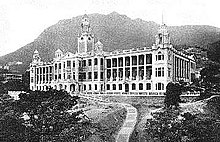

The University of Hong Kong was founded in 1911 when Governor Sir Frederick Lugard proposed to establish a university in Hong Kong to compete with the other Great Powers opening universities in China, most notably Prussia, which had just opened Tongji University in Shanghai. The colonial Hong Kongers shared British values and allowed Britain to expand its influence in southern China and consolidate its rule in Hong Kong.[citation needed]

Indian businessman Sir Hormusjee Naorojee Mody learned of Lugard's plan and pledged to donate HK$150,000 towards the construction and HK$30,000 towards other costs. The Hong Kong Government and the business sector in southern China, which were both equally eager to learn "secrets of the West's success" (referring to technological advances made since the Industrial Revolution), also gave their support. The Swire Group also contributed funds, partly wishing to bolster its corporate image following the death of a passenger on board one of its ships, Fatshan, and the subsequent unrest stirred by the Self-Government Society.[7] Along with other donors including the British government and companies such as HSBC, Lugard finally had enough to fund the building of the university.
As first Vice-Chancellor and Governor of Hong Kong, Lugard laid the foundation stone of the Main Building on 16 March 1910 and hoped that the university would educate more Chinese people in British "imperial values", as opposed to those of other Western powers.[citation needed] The university was incorporated in Hong Kong as a self-governing body of scholars on 30 March 1911 and had its official opening ceremony on 11 March 1912. The university was founded as an all-male institution. Women students were admitted for the first time only ten years later.[5]
As Lugard felt that the Chinese society at the time was not suited to ideals such as communism, the university originally emulated the University of Manchester in emphasising the sciences over the humanities.[citation needed] It opened with three founding faculties, Arts, Engineering and Medicine.[5][8] The Faculty of Medicine was founded as the Hong Kong College of Medicine for Chinese by the London Missionary Society in 1887.[9] Of the College's early alumni, the most renowned was Sun Yat-sen,[5] who led the Chinese Revolution, changed China from an empire to a republic. In December 1916, the university held its first congregation, with 23 graduates and five honorary graduates.
Move towards Chinese cultural education, and WW2

After the 1925–26 Canton-Hong Kong strikes, the government moved towards greater integration of Eastern culture, increasing the number of Chinese courses. In 1927, a degree in Chinese was created. Donations from wealthy businessmen Tang Chi Ngong and Fung Ping Shan – for whom campus buildings are named after – triggered an emphasis on Chinese cultural education. In 1937, the Queen Mary Hospital opened and has served as the university's teaching hospital ever since. In 1941, the Japanese invasion of Hong Kong led to the damage of university buildings, and the university closed until 1945.
1945 to 2001
Following the Second World War, the university reopened and underwent structural developments as post-war reconstruction efforts began in earnest, requiring more investment in law and social sciences. The Faculty of Social Sciences was established in 1967 and the Law Department in 1969. The student population in 1961 was 2,000, four times more than in 1941.
In 1982, the Faculty of Dentistry, based at the Prince Philip Dental Hospital, was established. It remains to this day Hong Kong's only faculty training dental professionals. In 1984, both the School of Architecture and School of Education became fully-fledged faculties, and in the same year a separate Faculty of Law was created. The Faculty of Business and Economics was established in 2001 as the university's tenth and youngest faculty.
After 1989, the Hong Kong government began emphasizing local tertiary education, retaining many local students who would have studied abroad in the United Kingdom. In preparation for the 1997 handover, it also greatly increased student places and course variety. Consequently, by 2001 the student population had grown to 14,300 and over one hundred degree courses were available to students.
2001 to present
The year 2001 marked the 90th Anniversary of HKU. Growing with Hong Kong: HKU and its Graduates – The First 90 Years was published by the University Press in 2002 as an impact study on HKU's graduates in different fields of Hong Kong.
In January 2006, despite protest from some students and various alumni, the Faculty of Medicine was renamed as the Li Ka Shing Faculty of Medicine "as a recognition of the generosity" of Mr. Li Ka Shing and his Foundation, who pledged HK$1 billion in support of the university "general development as well as research and academic activities in medicine".[citation needed]
On 16 August 2011 Communist Party of China Vice Premier Li Keqiang began a three-day visit to promote development between Hong Kong and mainland China.[10][11] The university was locked down and mishandled by the local police force causing the Hong Kong 818 incident.[12] In a statement to the HKU community, the university's Vice-Chancellor, Professor Lap-chee Tsui, admitted that the security arrangements could have been better planned and organised, and apologised to the university's students and alumni for not having been able to prevent the unhappy incident. He assured them that "the University campus belongs to students and teachers, and that it will always remain a place for freedom of expression".[13] On 30 August 2011, the university's Council resolved to set up a panel to review issues arising from the State leader's visit, in order to improve arrangements and establish policies for future university events that is consistent with its commitment to freedom of expression.
From 2010 to 2012, the university held Centenary Celebrations to mark its 100th anniversary. It also marked the opening of the Centennial Campus located at the western end of the university site in Pokfulam.[14] The University of Hong Kong-Shenzhen Hospital (also known as Binhai Hospital), which is operated by the university, also opened in 2011.[15][16]
Shield, motto and coat of arms
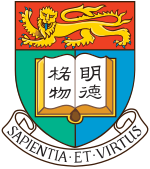
The design of the university's shield of arms was proposed to the College of Arms by the university in October 1912.[17] On 14 May 1913, the shield, along with two mottoes (one in Latin, one in Chinese) were granted by the College of Arms.[17] The field resembles the lions on the coat of arms of England, whereas the book on the shield is a common reference to university's role in learning and knowledge.
The Latin motto Sapientia et Virtus translated into English as "Wisdom and Virtue". The Chinese motto on the pages of the opened book, written from right to left, top to bottom in accordance with traditional Chinese writing direction, contains two phrases: 明德 (ming tak) and 格物 (kak mat), meaning "illustrious virtue" and "the investigation of things" respectively. The first phrase ming tak makes homage to the opening sentence of classic Confucian Classical Chinese literature the Great Learning, in which the author discusses the three great duties of a ruler: illustrious virtue, the renewal of the people, and repose in the highest good.[17] The second phrase kak mat is a reference to the writing of Confucian scholar Zhu Xi 致知在格物 (lit. exhausting by examination the principles of things and affairs). The phrase occurs in discussion regarding how wise rulers set about cultivating wisdom and virtue. If one desires to rectify their heart, they must first sought to be sincere in their thoughts. Wishing to be sincere in their thoughts, they must first extended to the utmost their knowledge. Such extension of knowledge lay in the investigation of things.[17]
In 1981, the year of the university's 70th anniversary, an application was made to the College of Arms for a full coat of arms, which was granted in 1984, comprising the original shield and mottoes with the addition of a crest, supporters, a helmet and compartment. The supporters of the coat of arms are a Chinese dragon and a lion representing Britain, indicating the university's aspiration to blend East and West cultures, from the foundation by British people in Hong Kong and the later development of the university's research and studies in both west and east culture and technology, whereas the compartment is an allusion to Hong Kong Island, where the university is located.
Campus
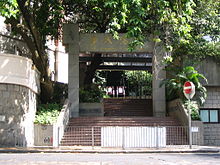

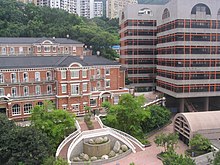
The university's main campus covers 160,000 square metres of land on Bonham Road and Pokfulam Road in the Mid-Levels of Hong Kong Island. HKU buildings are some of the few remaining examples of British Colonial architecture in Hong Kong.
The Li Ka Shing Faculty of Medicine is situated 4.5 km southwest of the main campus, in the Southern District near Sandy Bay and Pokfulam. The medical campus includes Queen Mary Hospital, the William M.W. Mong Building and research facilities. The Faculty of Dentistry is situated in the Prince Philip Dental Hospital, Sai Ying Pun.
The university also operates the Kadoorie Agricultural Research Center, which occupies 95,000 square metres of land in the New Territories, and the Swire Institute of Marine Science at the southern tip of the d'Aguilar Peninsula on Hong Kong Island.
Main Building

Constructed between 1910 and 1912, the Main Building is the university's oldest structure and was sponsored by Sir Hormusjee Naorojee Mody and designed by Architect Messrs Leigh & Orange.[18] It is built in the post-renaissance style with red brick and granite and has two courtyards. The main elevation is articulated by four turrets with a central clock tower (a gift from Sir Paul Chater in 1930). The two courtyards were added in the south in 1952 and one floor in the end block in 1958. The building was originally used as classrooms and laboratories for the Faculty of Medicine and Engineering and was later the home of departments within the Faculty of Arts. The central Great Hall (Loke Yew Hall) is named after Loke Yew, a benefactor of the university in its early years. It became a declared monument in 1984.[19]
Swire Building
In around 1980, the Swire Group sponsored the building of a new residential hall in the eastern end of the campus. Because of the sponsorship, the new student residence was named Swire Building. The building was officially opened by Mr. John Anthony Swire, C.B.E. on 11 November 1980. In 1983, the colour orange was chosen to be the hall colour in the second Annual General Meeting since the colour was used as the background colour during the first open day of Swire Hall and no other halls using orange as their hall colour.
In 1983, Mrs. J. Lau (Director of Centre Media Resources) provided a design of a hall logo. The Swire Hall Students』 Association, HKUSU, then made some amendments to that design. The logo shows the words 『S』 and 『H』, which is the abbreviation of Swire Hall. The design of the word 『S』 looks like two hands holding together, signifying that all hall-mates should cooperate with each others, and promotes the hall motto 『Unity and Sincerity』.
Hung Hing Ying Building

Financed by Sir Paul Chater, Professor G. P. Jordan and others, it was opened in 1919 by the Governor of Hong Kong Sir Reginald Stubbs and housed the students' union. After World War II, the building was used temporarily for administrative purposes. The East Wing was added in 1960. The building was converted into the Senior Common Room in 1974. It was named in honour of Mr Hung Hing Ying in 1986 for his family's donations to the university. The building was subsequently used again for administrative purposes, and now houses the Department of Music. The two-storey Edwardian style structure is characterised by a central dome and the use of red brick to emulate the Main Building opposite. The building became a declared monument in 1995.
Tang Chi Ngong Building
The idea to establish a school of Chinese was proposed in the inter-war period. Construction of the premises began in 1929 following a donation from Tang Chi-ngong, father of the philanthropist Sir Tang Shiu-kin, after whom the building was named. It was opened by Sir William Peel, Governor of Hong Kong, in 1931 and since then further donations have been received for the endowment of teaching Chinese language and literature. The building has been used for other purposes since the 1970s but the name remained unchanged. At present, it houses the Centre of Asian Studies. This three-storey flat-roofed structure is surfaced with Shanghai plaster and became a declared monument in 1995.
University Museum and Art Gallery
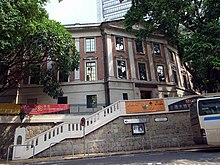
The three-storey Fung Ping Shan Building was erected in 1932 originally as a library for Chinese books. Named after its donor, the building consists of masonry on the ground level surmounted by a two-storey red-brick structure with ornamental columns topped by a pediment over its entrance. Since 1962, the Chinese books collection, now known as the Fung Ping Shan Library, was transferred to the university's Main Library and the whole building was converted into a museum for Chinese art and archaeology. Among its collections are ceramics, pottery and bronze sculptures. In 1996, the lowest three floors of the new T. T. Tsui Building were added to the old building to form the University Museum and Art Gallery.
Centennial Campus


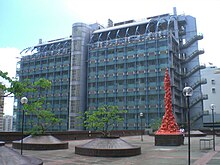
To provide additional space for students under the new four-year undergraduate curriculum the Centennial Campus was built at the western end of the main campus, which was previously occupied by the Water Supplies Department.[20] The construction of the campus started in late 2009, and was completed in 2012, the first year of the introduction of the new academic structure in Hong Kong. In 2012, the Faculty of Arts, the Faculty of Law and the Faculty of Social Science moved to the Centennial Campus.
Administration
The university's Chancellor is the Chief Executive of Hong Kong, Leung Chun-ying. The Pro-Chancellor is David Li. The Chairman of the University Council is Dr. Leong Che Hung. The Vice-Chancellor and President is Professor Lap-Chee Tsui. The Deputy Vice-Chancellor and Provost is Professor Roland T. H. Chin, and the Pro-Vice-Chancellors and Vice-Presidents are Professors S. P. Chow, J. G. Malpas, Paul K. H. Tam and Amy B. M. Tsui. The academic staff population was 6,105 in October 2011.[1]
Professor Ian Davies was the Vice-Chancellor for two years before a worldwide search culminated in the selection of Professor Lap-Chee Tsui as the new head of the university in 2002.
The business school (now part of the Faculty of Business and Economics) was founded by Gordon Redding.
Governance Structure
The Court
The Court is a large overseeing and legislative body comprising University and lay members. The purpose of the Court is to represent the wider interests of the communities served by the University. It has the power to make, repeal and amend statutes.
The Council
The Council is the governing body of the University, and is responsible for the management of financial and human resources of the University and for the University's future developments. The Council comprises University members (both staff and students) and lay members (i.e. persons who are not employees or students of the University), with a ratio of lay to university members of 2:1 Members are serving on the Council as trustees in their personal capacity.
The Senate
The Senate is the principal academic authority of the University. It is responsible for all academic matters and welfare of students. Its 50 members are mainly academic staff while there are also student representatives.[21]
Research and endowment
The university is a founding member of Universitas 21, an international consortium of research-led universities. HKU benefits from a large operating budget supplied by high levels of government funding compared to many Western countries. In 2012/13, the Research Grants Council (RGC) granted the University of Hong Kong a total research funding of HK$1,088 million, which is the highest among all universities in Hong Kong.[22] HKU professors were among the highest paid in the world as well, having salaries far exceeding those of their U.S. counterparts in private universities. However, with the reduction of salaries in recent years, this is no longer the case.[citation needed]
HKU research output, researchers, projects, patents and theses are profiled and made publicly available in the HKU Scholars Hub.[23] 100 members of academic staff (>10% of professoriate staff) from HKU are ranked among the world's top 1% of scientists by the Thomson Reuters' Essential Science Indicators, by means of the citations recorded on their publications.[24] The university has the largest number of research postgraduate students in Hong Kong, making up approximately 10% of the total student population. All ten faculties and departments provide teaching and supervision for research (MPhil and PhD) students with administration undertaken by the Graduate School.
Demographics
According to the latest profile indicators,[25] the student population of the university was 21,652 in 2008–2009, comprising 11,962 undergraduates, 7,326 taught postgraduates and 2,364 research postgraduates. In recent years, it has become a popular choice for international students, with 6,814 non-local students on campus (including exchange students) from 83 countries in 2012.
HKU attracts some of the best students from the world in Hong Kong. The university has for many years been ranked as the best in Hong Kong for its admission standards.[26] It accepts most of its undergraduate students from graduates of local secondary schools through the Joint University Programmes Admissions System (JUPAS). In 2012, all of the top scoring students, with seven 5** grades in the new Hong Kong Diploma of Secondary Education examination, enrolled in HKU, while there were altogether around 70,000 applications in total for undergraduate study, 23,852 of which were from outside the Hong Kong schools system.[27] In 2013, HKU again admitted, by far, the best of the students from Hong Kong, while students with five A*s in GCE ALE, 75/75 in the Taiwan GSAT, and 45/45 in the IB also joined HKU. The University also admitted 16 Zhuang Yuan (the top scoring students in their province or provincial city) from Mainland China.[28]
Academics
Academic organisations
Faculties, schools and departments
The university comprises ten faculties, one graduate school and a number of non-faculty academic units, which provide various study programmes and courses for students.[29] The medium of instruction in classes is English.[30]
- Faculty of Architecture
-
- Department of Architecture
- Department of Real Estate and Construction
- Department of Urban Planning and Design
- Division of Landscape Architecture
- Faculty of Arts
-
- School of Chinese
- School of English
- School of Humanities
- Department of Comparative Literature
- Department of Fine Arts
- Department of History
- Department of Linguistics
- Department of Music
- Department of Philosophy
- School of Modern Languages and Cultures
- Department of Japanese Studies
- Interdisciplinary Programme in American Studies
- Interdisciplinary Programme in European Studies
- Centre for Applied English Studies
- Faculty of Business and Economics
-
- School of Business
- School of Economics and Finance
- Faculty of Dentistry
- Faculty of Education
-
- Division of Chinese Language and Literature
- Division of English Language Education
- Division of Information and Technology Studies
- Division of Learning, Development and Diversity
- Division of Policy, Administration and Social Sciences Education
- Division of Science, Mathematics and Computing
- Division of Speech and Hearing Sciences
- Faculty of Engineering
-
- Department of Civil Engineering
- Department of Computer Science
- Department of Electrical and Electronic Engineering
- Department of Industrial and Manufacturing Systems Engineering
- Department of Mechanical Engineering
-
- Department of Law
- Department of Professional Legal Education
-
- Department of Anaesthesiology
- Department of Anatomy
- Department of Biochemistry
- School of Chinese Medicine
- Department of Clinical Oncology
- Department of Diagnostic Radiology
- Department of Family Medicine and Primary Care
- Department of Medicine
- Department of Microbiology
- School of Nursing
- Department of Obstetrics and Gynaecology
- Department of Ophthalmology
- Department of Orthopaedics and Traumatology
- Department of Paediatrics and Adolescent Medicine
- Department of Pathology
- Department of Pharmacology and Pharmacy
- Department of Physiology
- Department of Psychiatry
- School of Public Health
- Department of Surgery
- Faculty of Science
-
- School of Biological Sciences
- Department of Chemistry
- Department of Earth Sciences
- Department of Mathematics
- Department of Physics
- Department of Statistics & Actuarial Science
- Faculty of Social Sciences
-
- Department of Geography
- Department of Politics and Public Administration
- Department of Psychology
- Department of Social Work and Social Administration
- Department of Sociology
- Journalism and Media Studies Centre
- Graduate School
Affiliated institutions
School of Professional and Continuing Education (SPACE)
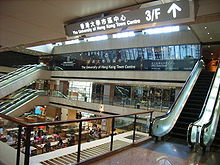
HKU SPACE was established in 1956 as the Department of Extramural Studies and changed its name in 1992.[31] It provides continuing education on a wide range of subjects, such as Japanese language and Mandarin language courses. It also runs programmes without subsidy from the Hong Kong Government and has set up community college-type institutions, somewhat similar to community colleges in the US.[32] HKU SPACE Community College, as one of them, was established in March 2000. It mainly provides sub-degree programmes for Form 5 or Form 7 graduates to further their studies. There are three main streams of programmes provided, they are Higher Diploma Programmes (2-year and 3-year full-time), Pre-Associate Degree (1-year full-time) and Associate Degree (2-year full-time).
Centennial College
Centennial College is a liberal arts college established in 2012 and it is part of the HKU group. It pays tribute to the University of Hong Kong in recognising the 100 years of commitment the university has made to academic excellence. The College is continuing the efforts to encourage a lifetime of self-cultivation for today's generation of students. It provides unique, multifaceted, self-financed, 4-year bachelor degree programmes for HKALE, HKDSE and other graduates from September 2012. Academic programmes that will be offered include: a Bachelor of Professional Accounting (Honours) degree course and a Bachelor of Arts (Honours) degree course with majors in Integrated Business, Language and Communication, China Studies and Global Studies.[33]
Libraries
HKU Libraries (HKUL) was established in 1912 and is the oldest academic library in Hong Kong with over 2.3 million holdings. A web-based library catalogue, DRAGON, allows one to search HKUL's books, journals and other resources.
HKUL now comprises the Main Library and six specialist branch libraries: the Dental, Education, Fung Ping Shan (East Asian Language), Yu Chun Keung Medical, Lui Che Woo Law, and Music libraries. They are located in buildings around the campus with varying opening hours.
HKUL Digital Initiatives
The HKUL Digital Initiatives, through its digitisation projects, has opened up online access to local collections originally in print format. The first HKUL Digital Initiative, ExamBase, was launched in 1996 and other projects of scholarly interests were introduced. More digital projects are being developed to provide continuous access to digital content and services. It provides open access to Chinese and English academic and medical periodicals published in Hong Kong.
Language policy
English is the language of instruction, and the university's Senate has endorsed English as the campus lingua franca. Under the four-year curriculum introduced in 2012 local students are required to take English language and Chinese language courses, however, students who are native-speakers of languages other than Chinese, and students who have not studied Chinese language in their secondary school curriculum can take an elective course instead.[34]
Reputation and rankings
Template:Infobox world university ranking The QS World University Rankings (2013/14) placed it at 26th worldwide, making it the second in Asia and first in Hong Kong. Yet, it had in fact been the best Asian university of such league tables for 3 consecutive years from 2010/11 to 2012/13.[35][36][37] The independent regional QS Asian University Rankings (2013) considered it second in both Asia and Hong Kong.
Meanwhile, the university was 43rd in the world and 3rd in Asia in the Times Higher Education World University Rankings (2013–14), and 36th in its World Reputation Rankings,[38] both of which regarded it first in the territory.
Moreover, the ARWU (2013) listed it at a position among 201st-300th globally and 2nd-3rd in Hong Kong.[39]
Apart from the above overall rankings, the institutions have also provided university rankings by disciplines. See list of subject rankings of Hong Kong tertiary institutions for some major subject rankings.
In 2008, the University of Hong Kong was ranked in the Top 50 worldwide by the Human Resources & Labor Review, one of the only three Chinese universities in the list. HKU's MBA program was considered the best in Asia by the Economist's 2012 ranking, ranking it 41st globally.[40] Another ranking, the Global MBA Rankings (2013), placed HKU's MBA program at 31st in the world and 5th in Asia.[41] The Finance Times EMBA Rankings also ranked HKU's HKU-Fudan IMBA program at 54th worldwide and the third in Hong Kong,.[42]
Student life
Student welfare is served by several units, including the Centre of Development and Resources for Students (CEDARS), which provides guidance for most areas of student life including career counselling, and the University Health Service, which provides health care, referrals and preventive services.
Student services
These include:
- Career Education and Placement Centre
- Information Technology Services
- Centre of Development and Resources for Students
- Personal Development and Counselling Centre
- Sports and Recreation Programmes/Facilities
- University Dental Service
- University Health Service
- University Museum and Art Gallery (formerly Fung Ping Shan Museum)
Student accommodation and hall education
Residential halls
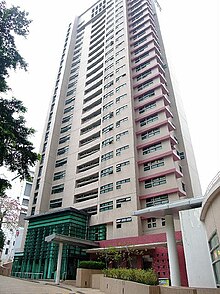
Mainly co-ed shared rooms unless specified.
- St. John's College (co-ed undergraduates and postgraduates, an Anglican Foundation College, single room)
- Morrison Hall (male undergraduates and co-ed postgraduates)
- Ricci Hall (male only, run by Jesuit Fathers, single room)
- Lady Ho Tung Hall (female only)
- University Hall (male only)
- Robert Black College (named after Governor Robert Black, postgraduates and visitors only)
- Swire Hall
- Simon K. Y. Lee Hall
- Lee Hysan Hall
- R.C. Lee Hall
- Wei Lun Hall
- Madam S.H. Ho Residence for Medical Students
- Pokfield Road Residences
- Graduate House (postgraduates only)
- Starr Hall (largest residential hall in HKU)
- Patrick Manson Student Residences
- Lee Shau Kee Hall
- Suen Chi Sun Hall
Non-residential halls
- Hornell Hall (male only)
- Duchess of Kent Hall (female only)
- Lee Chi Hung Hall (co-educational)
Residential Colleges
The Residential Colleges on Lung Wah Street at Kennedy Town are made up of four blocks and was founded in September 2012. It provides a total of 1,800 beds for students of whom 67% are non-local students. Traditional functions of halls are partly kept in Residential Colleges such as high table dinners.
Student organisations

There are two officially recognised student bodies, The Hong Kong University Students' Union (HKUSU) and Postgraduate Students Association, giving opportunities for students to participate in extracurricular activities.
HKUSU principally serves the undergraduate students. It offers more than 100 clubs and associations catering to the student population. This organization is renowned amongst student activists, having been the main driving force behind evicting a chancellor in recent years. There was controversy when the head of the Students' Union, Ayo Chan, said that some of the protesters involved in the Tiananmen Square Massacre had acted irrationally.[43] Many students thought his remarks were offensive and he was ousted by a vote in under one week. The Postgraduate Students Association (PGSA) represents the university's postgraduate students.
Study abroad programme
Through the Exchange Buddy Program, students from abroad can choose to be matched with a local student whom they can correspond with prior to their departure for Hong Kong. These local students greet the visiting students upon arrival at the airport, assist with settling into student residence and offer advice and support during their stay.[44]
More than 3,000 students have participated in the exchange programmes through universities spanning 18 countries around the world with the support of the University Grants Committee, University of Hong Kong Foundation for Educational Development and Research, Hongkong Bank Foundation, UBC Alumni Association (Hong Kong), Dr. Lee Shiu Scholarships for Hong Kong and South-East Asia Academic Exchange, Shell (Hong Kong) Limited, C. V. Starr Scholarship Fund, and other donations.[45]
People

The University of Hong Kong has educated many notable people. Among them is Dr Sun Yat-sen, founding president of the Republic of China, who was a graduate of the Hong Kong College of Medicine for Chinese, the predecessor of HKU. Over 40 principal officials, permanent secretaries, Executive Council and Legislative Council members of the Hong Kong SAR Government are HKU graduates. HKU graduates also form the senior management teams of many large organisations in the private sector.
See also
- Education in Hong Kong
- Hong Kong University Students' Union
- List of buildings and structures in Hong Kong
- List of higher education institutions in Hong Kong
- List of oldest universities in continuous operation
- University of Hong Kong Faculty of Law
References
- ^ a b c http://www.cpao.hku.hk/qstats/staff-profiles
- ^ a b c http://www.cpao.hku.hk/qstats/student-profiles
- ^ "HKU Quick Stats - Space".
- ^ HKU Centenary Signature
- ^ a b c d "About HKU - History". The University of Hong Kong. Retrieved 16 July 2013.
- ^ "WHO-SARS Update 12 (SARS virus close to conclusive identification, new tests for rapid diagnosis ready soon)".
Scientists at Hong Kong University had previously announced, on 21 March, the isolation of a new virus that was strongly suspected to be the causative agent of SARS. (5th paragraph)
- ^ Taikoo by Charles Drage published 1970, pages 170-2
- ^ "About HKU Faculty of Arts".
- ^ HKU Li Ka Shing Faculty of Medicine – About Us – History and Development
- ^ 馬玉佳 (17 August 2011). "Li Keqiang expresses support to Hong Kong". China.org.cn. Retrieved 30 August 2011.
- ^ 新聞. "港大人圍攻 徐立之含淚 千人校園悼自由 徐:完全支持學生 - 本港新聞 - MSN 新聞". News.hk.msn.com. Retrieved 30 August 2011.
- ^ 馬玉佳 (17 August 2011). "Li Keqiang expresses support to Hong Kong". China.org.cn. Retrieved 30 August 2011.
- ^ Tsui, Professor Lap-Chee. "About The University of Hong Kong Centenary Ceremony". The University of Hong Kong. Retrieved 7 November 2011.
- ^ "Forward to the second century". The University of Hong Kong. Retrieved 13 August 2013.
- ^ Yang, Calvin; Lau, Joyce (14 July 2013). "University of Macau Moves Over the China Border". New York Times. Retrieved 13 August 2013.
- ^ Sasin, Jasmin (28 July 2011). "Binhai Hospital to Open Before the Year Ends". Shenzhen Standard. Retrieved 13 August 2013.
- ^ a b c d "About HKU". University of Hong Kong. Retrieved 21 April 2010.
{{cite web}}: Cite has empty unknown parameter:|coauthors=(help) - ^ "From British Colonization to Japanese Invasion" (PDF). HKIA Journal (45: 50 years of Hong Kong Institute of Architects): 47. 30 May 2006.
- ^ University of Hong Kong: Visit HKU Heritage Buildings: The Main Building
- ^ "HKU Centennial Campus - Heritage". Retrieved 25 May 2013.
- ^ http://www.hku.hk/about/governance/governance_structure.html#court
- ^ "The University Grants Committee Statistics".
- ^ HKU Scholars Hub http://hub.hku.hk/
- ^ HKU Scholars in the Top 1% http://hub.hku.hk/local/top1pc/top1pc.jsp
- ^ http://www.hku.hk/about/profile.html
- ^ http://www.education18.com
- ^ http://www.als.hku.hk/pdf/HKU130131.pdf
- ^ <http://www.cpao.hku.hk/publications/firstandforemost/first-and-foremost/en/beststudents.htm>
- ^ "The University of Hong Kong - Faculties".
- ^ "HKU - Undergraduate Admissions".
- ^ [1]
- ^ HKU SPACE – Introduction to the School
- ^ Centennial College - The Origin of Enlightenment http://www.centennialcollege.hku.hk/en/the-origin-of-enlightenment.php
- ^ "Language Provision and Support". The University of Hong Kong. Retrieved 13 August 2013.
- ^ "QS World University Rankings (2012/13)".
- ^ "QS World University Rankings (2010)".
- ^ "QS World University Rankings (2011)".
- ^ "Times Higher Education World Reputation Rankings (2012-13)".
- ^ "ARWU 2013".
- ^ "The Economist Which MBA? 2012 Full time MBA ranking". The Economist. 2012. Retrieved 14 January 2012.
- ^ "World's Top MBA School Ranking in 2013". Financial Times. 2013. Retrieved 28 January 2013.
- ^ "Financial Times EMBA Rankings 2012".
- ^ http://app2.rthk.org.hk/pda/news/content.php?id=576943
- ^ Asia Learn University of Hong Kong http://www.asialearn.org/Universities/UnivHongKong.htm
- ^ Office of International Student Exchange http://www.hku.hk/liaison/oise/
External links
- Official website
- HKU Glossary on Blogger
- Wong & Ouyang (HK) Ltd., "More than half-a-century of architectural design experience in Hong Kong", section "Master Planning of the main campus and the centennial campus of the University of Hong Kong", pp. 44–48, September 2009
